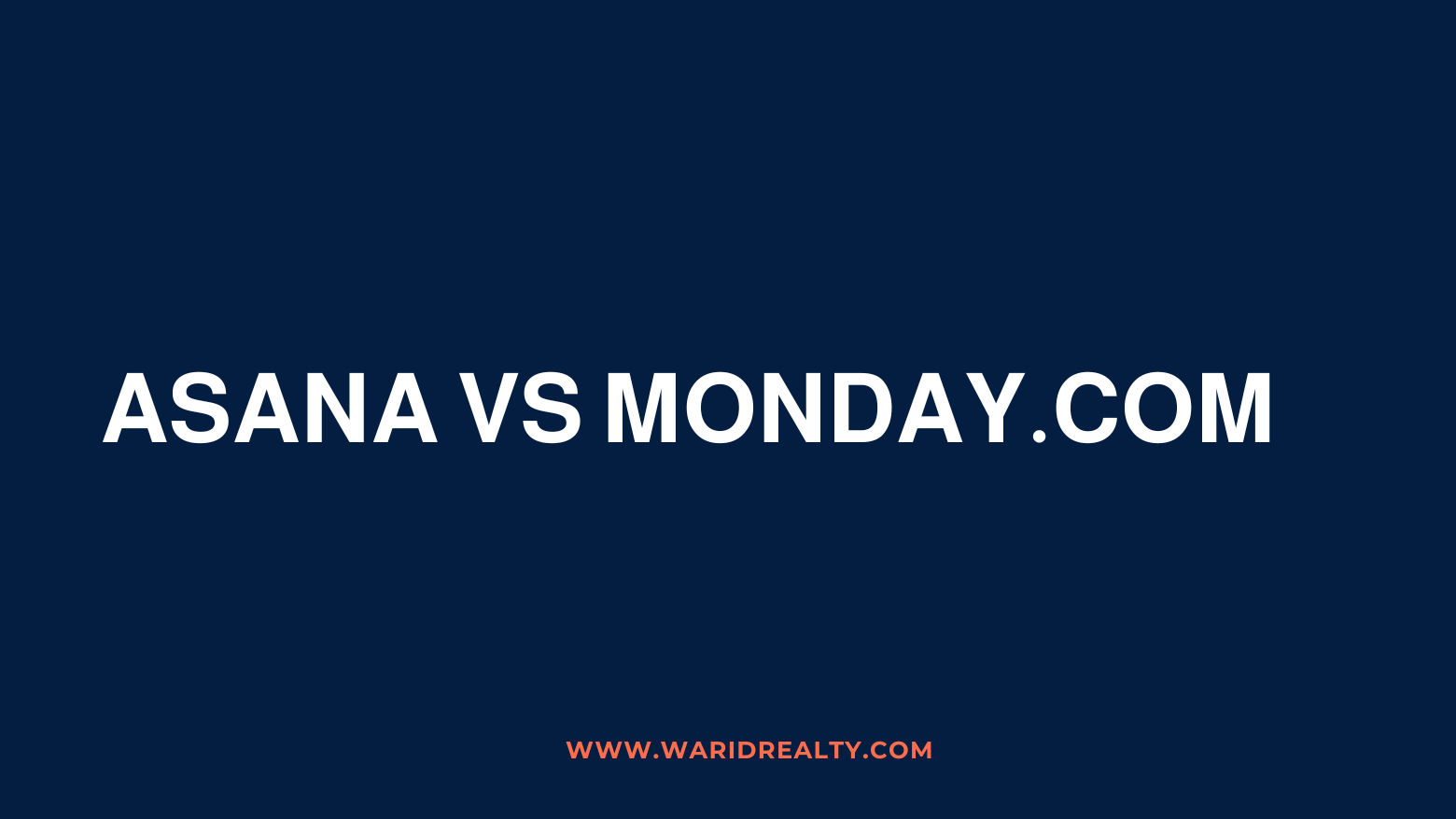One constant in this period of constant upheaval is the widespread admiration of project management programs. A common debate among users is Asana vs. Monday, as both platforms offer unique features and benefits.
They’re quite dedicated to their preferred software. But we encourage you to put down your pitchfork and extinguish your light for a minute, for more divisiveness will only make a world that is already at war with itself even more so.
There has to be a level-headed, unbiased conversation regarding the relative merits of two popular project management tools, Asana vs. Monday.
You may have already decided between these two options for project management, but if you’re still looking, we can help you save a lot of time. To learn more about Asana vs. Monday, read the in-depth article below.
What are the core features of Asana and Monday?

Workflow Management
You may break down Asana project management workflows into distinct “views.” Lists, Kanban boards, Gantt charts, and calendars are all useful tools for tracking the development of your projects. The drag-and-drop interface and task dependencies ensure that even the most ambitious projects stay on track.
Monday.com workflow manager functions similarly, except it provides access to many Pulse visualizations without requiring the user to go between pages or tabs repeatedly.
The Monday UI shows an always-present list view of your Pulses, along with a little progress meter for each, while it displays the visualization of your choosing in part above the fold.
Good for busy project managers who need a bird’s-eye view of everything. Monday.com’s list section has a pull-down option for updating Pulse statuses, but you can also alter Pulse sizes in the timeline view (Gantt chart) and rearrange card positions in the boards’ view (Kanban board). Monday task managers may also display projects as maps and pie charts.
Task Management
Using asana project templates, you may create tasks, distribute them to team members, establish due dates and deadlines, and make them reliant on one another.
When you click on a task, it will expand to provide additional information, allowing you to add comments with @ mentions and attach files for group work. You may see the full list of your assigned tasks by going to My Tasks after signing in to Asana, so you don’t have to wonder what is asana. The Home section includes tasks that are due soon.
Portfolio Management
In many ways, Monday.com resembles this, but it refers to its equivalent duties as “Pulses” on its To Do Lists. Unlike Asana tasks, Pulses don’t always appear as cards, although that’s one way to visualize them.
You can name each Pulse, assign it to a team member, set its status, link it to other Pulses, and display its estimated completion time in a convenient progress bar, among other features.
Asana and Monday.com, task management software, stand out among other PM solutions for SMBs because they have robust project portfolio management capabilities.
The portfolio function in asana training is similar to a traditional project management tool; only it’s used for whole projects rather than single tasks. Using this function, you may step back from your regular environment to assess the larger picture and avoid dropping any balls.
Monday.com offers a similar function called Groups. If you’re curious about what Monday.com is, once a user creates a new Pulse, they can either add it to an existing Group or keep it standalone.
Organizations are only sometimes jobs or initiatives. Instead, you may transform Pulses into whatever you choose because of their malleable structure. The best way to keep track of your projects is in a Group. When managing your portfolio, this method may provide as much information or insight as the portfolio function in Asana. Still, it may help you avoid the perils of narrow focus.
Security
There has been an uptick in the number of businesses placing a premium on digital security, so you must investigate the measures these PM systems take to safeguard your information and those of your consumers. Both platforms comply with the General Data Protection Regulation (GDPR), the EU-US Privacy Shield, and Service Organization Controls (SOC) 1 and 2. Still, if you operate in a highly regulated industry like healthcare or finance, you may require extra security measures like SOC 3 and HIPAA with a monday.com login.
There is little advantage to asana training in this regard. Two-factor authentication (2FA) is available with both methods. Asana also supports SSO through Google in addition to Okta and OneLogin, whereas Monday.com supports SSO with these and other major applications. With this and two-factor authentication, your account will be as safe as it can be.
Integrations
Asana integrations provide the most useful integrations compared to other project management tools. Asana has over 200 different connections, including but not limited to Dropbox, Slack, GitHub, and MailChimp. Along with its API, Asana also works with Zapier.
On Monday, you may use the site’s 40 integrations and API. Monday integrations are worth considering; they include Slack, Jira, Google Drive, Shopify, Zapier, and Mailchimp. For smaller businesses, this may be sufficient, but larger enterprises would likely benefit from setting up API data sharing.
Collaborations
This project management software places a premium on collaboration. Asana moves the task to another project. Asana is an online project management application that allows users to invite people to their virtual offices to encourage collaborative collaboration. It also alerts team members when an internal task is changed. Individual team members’ tasks are shown and may be commented on in real-time. Asana blends project management tools with collaboration capabilities.
Monday.com is a full-featured huddle space, so there’s no need to switch between different programs to get work done. Monday.com is an online collaboration solution that makes it simple to share comments on documents, prompt, timely discussions, and delegate work in real-time.
Monday vs. Asana: Pricing
With asana app free plan, you and up to 10 coworkers may keep tabs on projects and see tasks in a list or on a Kanban board. However, the free version of Asana provides all the features necessary to manage basic tasks for small teams, freelancers, and solopreneurs.
Asana pricing-
- Personal: US$ 0
- Starter: US$ 10.99
- Advanced: US$ 24.99
- Enterprise: Contact sales
On Monday.com, you can create a free personal plan, but if you want access to premium features like dashboards, you’ll need to pay for an upgrade. The free edition of Monday.com offers limitless boards, over 200 themes, and 20 different kinds of columns.
Monday.com pricing-
- Free: $ 0
- Basic: $ 9 seat/month
- Standard: $ 12 seat/month
- Pro: $ 19 seat/month
- Enterprise: Contact sales
Pros and Cons of Using Asana
Pros (Asana)
- Simple to Operate: The Asana login user interface makes the app great overall. It has been meticulously crafted, making it very user-friendly. Asana’s straightforward layout and user experience make it easy to use. More important than the software’s raw strength is how simple it is to use.
- Integration on a Grand Scale: Asana Rebel is proud of how well it fits into your workflow. As a result, any flaws in the software itself are remedied. Asana may be used in tandem with various other project management tools, including Google Drive, Microsoft Teams, and Slack. So long as you use Asana, you can ensure that everything is taken care of.
- Concentrated on Teamwork: The emphasis of this project management software is on teamwork. Asana is an online project management service that facilitates group work by allowing users to add others to their virtual office. It also notifies team members if an internal task is updated. Tasks assigned to individual team members are shown and may be commented on in real-time. Asana combines project management tools with teamwork tools, and asana templates areavailable.
- Management of Tasks: Asana provides a well-structured and productive method for managing tasks, so it is clear what is workflow management. It provides an extremely comprehensive picture of all jobs for its consumers. Tasks may be prioritized. Asana’s task management features, including assigned tasks and real-time data, are unparalleled.
Cons (Asana)
- Inability to Monitor Time: Though it’s a project management application, its emphasis on tasks means that time tracking is absent. Most types of project management software include time-tracking features. The absence of one is Asana’s most serious shortcoming.
- Required Prior Knowledge and Experience: While Asana’s user interface is intuitive, mastering it takes practice. Because of its familiarity, Asana has won the hearts of many project managers. But that’s only because it has a familiar feel reminiscent of older project management practices and older software. It might be challenging to get a handle on project management from scratch.
Pros and Cons of Using Monday
Pros (Monday.com)
- Look and feel of the user interface: The user interface is attractive, and it allows for goal management. You can choose the number of columns to present the information you need on your dashboard. There is a high price to pay for this adaptability, though. The dashboard becomes too large and complicated to manage when numerous people work on a single project. As a result of the extensive information transmission required between your device and Monday’s servers, the dashboard takes a while to load.
- Notification Process: When important events occur in your project, such as when you are given work, or a job is done, the Monday project management software will send you an email. Since the Monday Project management software has yet to create a proper system for handling alerts, you may sometimes find yourself inundated with emails.
- Team communication: Monday’s workflow management software facilitates team communication via comments and forms. The user may annotate tasks and design documents. However, it lacks built-in communication features seen in competing for project management software. This makes it difficult to track the many talks about the project in one central location. More so than with competing project management tools, it makes it difficult to track down a specific thread of dialogue.
- Compatible with additional applications: Many popular services, such as Slack, Trello, and Google Docs, may be integrated with Monday, increasing productivity. At this time, it only works with customer relationship management platforms like salesforce. Monday’s support for Zapier is helpful, but it may be difficult to use with other programs.
Cons (Monday.com)
- Hard to keep track of how much time you spend on each job: Monday does not provide its employees with a means of monitoring how much time they spend on individual projects. Those who work with customers or hire outside help for projects will find this a significant challenge. In many cases, knowing how many hours your team spends on a project and how much it costs you depends on accurate time monitoring.
- Learning curve is steep: The learning curve for Monday’s UI and features is steep. This is the second most common criticism from users, behind the cost. Monday first seems amazing and beautiful, but it needs more structure when delivering information to the consumer. However, when the scope of the project expands and the project’s duration lengthens, along with the number of activities and the amount of communication involved, it becomes progressively more difficult to navigate and locate specific information.
Asana vs Monday (Wrap-Up)

Both monday.com and Asana are project management software that provides useful capabilities to help individuals and businesses manage projects, organize tasks, and interact across teams. Some companies might find monday.com a superior project management platform, whereas Asana is preferable for collaboration.
Asana vs. Monday FAQ
Asana is task- and workflow-focused, helping teams organize projects with tasks, dependencies, and timelines, whereas monday.com is highly visual and customizable, designed as a work operating system (Work OS) where you can manage projects, sales pipelines, HR processes, and more.
Asana is simpler for traditional project management and task tracking, whereas Monday.com offers more visual boards and flexibility, but can feel overwhelming at first due to its customization options.
Also read:
- Project Management Software: Best list
- ClickUp vs Monday.com: Ultimate Comparision
- Employee Management Software: Best List
